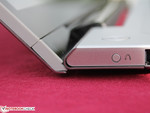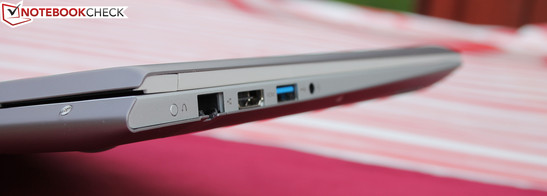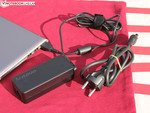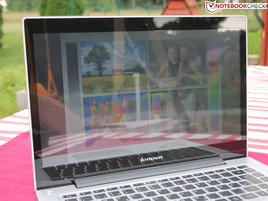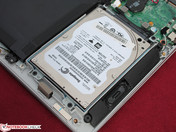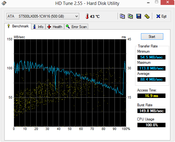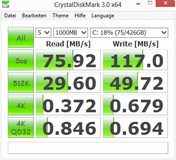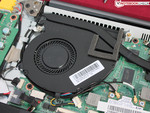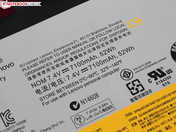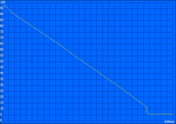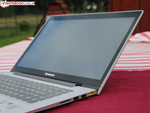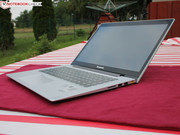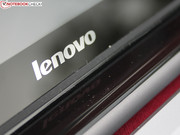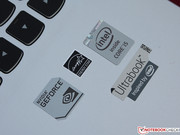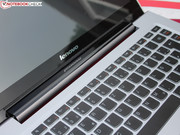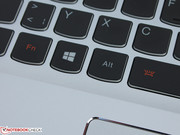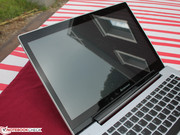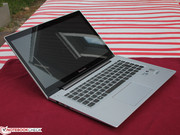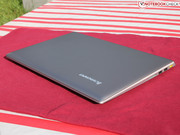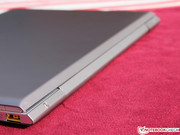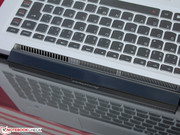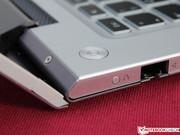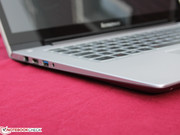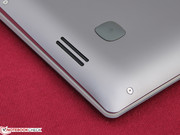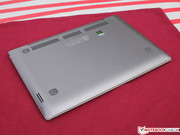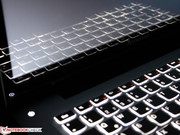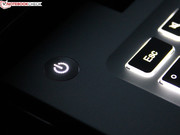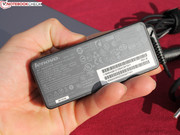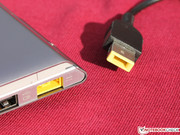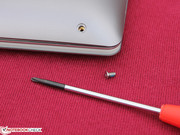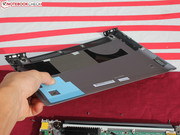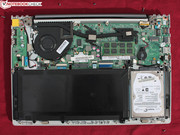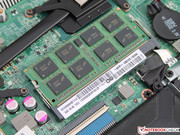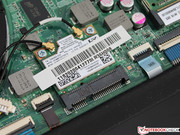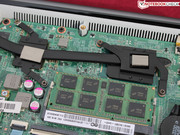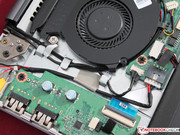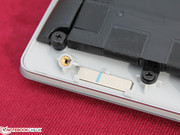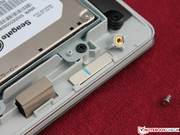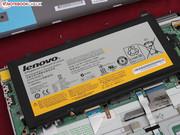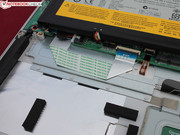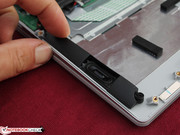Review Lenovo IdeaPad U430 Touch Ultrabook

For the original German review, see here.
Lenovo offers a wide variety of ultrabooks. There are 13-, 14- and 15-inch devices, although not all of them meet Intel's requirements in regard to the weight or dimensions respectively. This is not a problem for the customer as long as the higher weight results in a sturdy and high-quality device. The latter is realized by the aluminum finish of the display cover, base unit and interior. We already liked the solid construction of the U400 and U410, but the completely redesigned case is even better.
There is no lack of high quality aluminum competitors. Asus uses such a finish for its VivoBooks and Dell for its Inspiron 15z (cover). Acer uses a plastic case for the Aspire E1-572G, but it is also less expensive at 600 Euros (~$790). The configurations are mixed and dedicated mainstream graphics can usually be found in 15-inch notebooks. We consider the first two devices (bold) as main rivals and the other notebooks as alternatives
- Acer Aspire E1-572G-54204G75Mnkk (15.6-inch, HD 8750M) 600 Euros (~$790)
- Asus VivoBook S551LB-CJ026H (15.6-inch, GT 740M) 900 Euros (~$1185)
- Asus Zenbook UX32VD-R3001H (13.3-inch, GT 620M) 800 Euros (~$1054)
- Dell Inspiron 15z, Core i7-3517U, 6 GB RAM, 532 GB (5523-5680) 750 Euros (~$988)
- VivoBook S300CA-C1064H (90NB00Z1-M02210) HD 4000
- VivoBook S400CA-CA161H (90NB0051-M04640) HD 4000
- Acer Aspire TimelineU M5-481PTG-53314G12Mass (NX.M3XEG.001)
Case
The U430 is the successor of the IdeaPad U400 and the U410 Touch (both aluminum). Our review unit does not have many similarities with its older siblings since the chassis was completely redesigned. With success, the former problems with the stability are gone and it is perfect now. Lenovo uses a very thick base unit that covers the rear area (hinge). The components are hanging in a faceplate and an aluminum plate beneath the keyboard prevents flexing.
The result is a very torsion resistant base unit that does not have to hide behind an Asus Zenbook or Apple's unibody. Apart from the display cover, we cannot dent the case anywhere even with a lot of pressure. The connection between the hinge and the base unit is very firm and we actually needed both hands to open the display. Unfortunately, there is some bouncing at the maximum opening angle of around 135 degrees. The display cover is not really svelte but it is quite torsion resistant in return; the edge-to-edge display is protected by a circumferential rubber lip, which is supposed to prevent scratches from the glossy surfaces. It also seals the laptop when it is closed and no dirt or dust can get in between.
Connectivity
Compared to the U410, nothing changed in regard to the ports. We don't have to waive the Ethernet port but there is one USB 3.0 port less. The port layout is very convenient; the ports are very far at the back of the case.
Communication
You can either use wireless (Intel Wireless-N 7260 b/g/n) or wired (Gigabit Ethernet) networks with the U430. Can the wireless performance convince us? Yes, but mainly on short distances: The signal strength is excellent (4 or 5 bars) with a distance of three to ten meters (upstairs) but the signal is weak with a distance of 15 meters outside the house (2 bars) and there is no connection to the router at 40 meters. We already know that the Wireless-N 7260 has problems with longer distances from the Sony Vaio Pro 13 SVP-1321C5ER review. The transmitting power of the router (Fritz!Box 7270) is always reduced to 50%.
Webcam
The webcam has a resolution of 1280x720 pixels. Pictures are quite sharp but there is significant picture noise and the colors are unnaturally cool.
Accessories
Windows 8 (64-bit) is preinstalled on the U430 Touch but there are no recovery DVDs. Users can create them via OneKey Recovery and an external DVD burner (image for recovery). The recovery mode on the hidden HDD partition can be accessed via the OneKey button, which also works when the device is turned off. Lenovo Motion Control is supposed to enable motion controls via webcam, e.g. media player or volume control. However, our tests were not really successful.
Maintenance
The bottom cover can easily be removed with a small Phillips screwdriver; even beginners should have no problems. You can clean the fan or replace the battery and you can also gain access to the memory module (one slot, occupied), the 2.5-inch hard drive (7 mm), the WLAN module (mini PCIe) and the CMOS battery. Processor and graphics card are soldered onto the motherboard and there is also an unknown slot next to the CMOS battery. It is definitely not the flash memory (SSD cache of the HDD), this is integrated into the HDD itself (not listed separately).
Warranty
Lenovo grants a 24-month bring-in warranty for the U430. The device comes with a note that points out this advantage. Which service upgrades are available for my Lenovo device? You can easily determine this with the serial number on Lenovo's service website.
Input Devices
Keyboard
The plain AccuType-keys (typical for Lenovo) sit very deep in the base unit. Users will have to get used to the small Return and Backspace keys as well as the shifted arrow keys. After that there should be no problems due to the convenient spacing, the distinct travel and the firm key stroke (no bouncing).
The keys benefit from their smooth and rather velvety surface and the background illumination. The pressure point is clear but could be more accurate for our taste. Compared to real business inputs, it is harder to hit the right key due to the missing tapered curvature.
Touchpad
Operating the large ClickPad (12.5 centimeters diagonally) could have been enjoyable if there was more travel. But the fingers are tortured with a limited travel, which also requires significant force. There are no separate mouse buttons anymore; the software recognizes a left or a right click depending on the position of the finger. Gliding on the multi touchpad surface is convenient; the smooth surface has little friction resistance and only thwarts wet fingers.
Display
One interesting aspect of the U430 Touch is the 10-finger multitouch display (CMN N140FGE EA2) with a resolution of 1600x900 pixels. The 14-inch TN display replaces the common 1366x768 pixels that was the only option for the predecessors U400 and U410 Touch. The HD+ resolution improves working with Windows and is definitely an important aspect for many potential buyers.
Lenovo's business notebook ThinkPad X1 Carbon, for instance, also comes with this resolution (TN, LEN40A2). The competitor Aspire E1-572G is even available in a special version with a Full HD display, but that does not apply for the VivoBook S551LB. Asus' Zenbook UX32VD is only equipped with a Full HD screen in the more expensive configurations starting at 1,000 Euros (~$1317).
The panel is not anti-reflective and the brightness is not overwhelming either (196 cd/m²), at least it is not reduced on battery power. The competition is not much better and the VivoBook S551LB has the darkest screen with 171 cd/m².
| |||||||||||||||||||||||||
Brightness Distribution: 85 %
Center on Battery: 214 cd/m²
Contrast: 426:1 (Black: 0.5 cd/m²)
ΔE ColorChecker Calman: 10.84 | ∀{0.5-29.43 Ø4.78}
ΔE Greyscale Calman: 11.39 | ∀{0.09-98 Ø5}
36% AdobeRGB 1998 (Argyll 1.6.3 3D)
40.52% AdobeRGB 1998 (Argyll 3D)
57.5% sRGB (Argyll 3D)
39.34% Display P3 (Argyll 3D)
Gamma: 2.23
CCT: 14005 K
The contrast ratio of the CMN panel is just between the Aspire E1-572G (415:1) and S551LB (607:1). We measure 426:1, which is not very good. A high contrast ratio would be around 1000:1 and would result in dark blacks and crisp colors.
The color space coverage of the display is not sufficient for professional users with 53% sRGB and only 36% AdobeRGB. We also used a photo spectrometer and CalMAN software to check the color accuracy and the grayscale presentation with the sRGB target color space pre-calibration (in other words ex-works). The bad result shows a distinct blue cast for both the colors and the grayscale presentation. We were able to improve the situation with the calibration and the blue cast was noticeably reduced.
The low luminance below 200 cd/m² in combination with the strong reflections from the glossy display surface doesn't work well with direct sunlight; you can barely see the display content. You should look for a place in the shade.
The possible viewing angles are visibly limited to horizontal shifts; you can deviate up to around 45 degrees from the center before the colors start to invert. You should not change the angle vertically if possible, even small changes of 10-15 degrees result in inverting colors.
Performance
Lenovo is up to date in regard to the processor with the Intel Core i5-4200U (1.6 GHz Haswell); the dual-core CPU can raise its clock up to 2.6 GHz (2 cores: 2.3 GHz) via Turbo Boost. The chip also contains the integrated HD Graphics 4400 GPU, but the system can switch to the dedicated GeForce GT 730M in more demanding scenarios. Combined with the 500 GB HDD (Seagate ST500LX005-1CW162) with 16 GB integrated flash memory (SSD cache), the system should be well equipped and fast enough for many years. We will have a closer look at the performance in the following sections.
Processor
Is the cooling sufficient to maintain the maximum Turbo clock of the i5-4200U? Yes it is. Firstly, Acer's Aspire E1-572G is on a similar level (R11.5 Multi) with the same CPU and secondly the tools show that the CPU can use the maximum Turbo clock even under full load for both cores (2.3 GHz). The maximum CPU temperature is only 56 °C with simple CPU benchmarks, which is very low.
Asus' competitor VivoBook S551LB (+2%) with the i7-4500U (1.8 GHz) review configuration was not faster; the clock under load was similar with 2.3 GHz (Multi-Core). The alleged performance advantage of the 30% higher Turbo clock is eliminated because the cooling system cannot dissipate the resulting heat.
There are no problems with reduced performance on battery power, neither for the GPU (730M) nor the CPU. All Cinebench R11.5 results were identical on battery.
System Performance
We determine the system performance with PCMark 7 and PCMark Vantage and the results are very good for an HDD-based notebook. Devices with an SSD are sometimes even slower, for instance the Inspiron 15z (-7%) and Acer’s Aspire TimelineUltra M5-481TG (-9%).
Another notebook with an SSD cache is the VivoBook S400CA (-28%). We can see a clear performance disadvantage, which is not exclusively caused by the missing dedicated GPU. The System Storage score of the 14-inch device is 45% behind our U430 Touch, despite the 24 GB SanDisk U100 SSD cache. The difference compared to notebooks without an SSD cache is even bigger. Why is the Seagate ST500LX005 with its 16 GB flash memory so good?
| PCMark Vantage Result | 7480 points | |
| PCMark 7 Score | 3937 points | |
Help | ||
Storage Devices
Seagate’s hard drive with a gross capacity of 500 GB does not show good results in the common hard drive benchmarks. Sequential reading results of 76-88 MB/s are not overwhelming and the same applies for 512K and 4K blocks (reading). However, we were impressed by the good 512K write and sequential write results, which are up to 47% (VivoBook S300CA) ahead of conventional hard drives. Even the Asus UX32VD with an SSD cache is surpassed by 48%.
Graphics
The GeForce GT 730M (2048 MB, core: 719-758 MHz) is a mobile mainstream GPU. The usual benchmarks (in this case 3DMark 2013) indicate a performance advantage of around 60% over the integrated HD Graphics 4000 The Radeon HD 8750M leaves a mixed impression, Samsung’s Ultra Touch 740U3E (-27%) cannot utilize the maximum GPU-Turbo. This is not the case for the Aspire E1-572G (+31%). A GeForce 740M, which should be faster, only has an advantage of 1% (Asus VivoBook S551LB). 3DMark’s Fire Strike result without CPU load shows basically the same result (740M vs. 730M).
| 3DMark 06 Standard Score | 7754 points | |
| 3DMark Fire Strike Score | 920 points | |
Help | ||
Gaming Performance
Lenovo only uses a 64-bit memory interface for the GPU, which results in dropped frames in higher resolutions. But the relatively slow GT 730M does not offer sufficient performance for these resolutions anyway, many games are not even running smooth with 1366x768 pixels, high details and anti-aliasing. You should not really try the native resolution of 1600x900 pixels. The GT740M has an advantage of around 10% in games, a Radeon HD 8750M is another 34% ahead. The GT 730M is not really a convenient solution for ambitious gamers, however, it is significantly better (10-20%) than the 710M of the U410 (predecessor).
| Lenovo IdeaPad U430 Touch 59372369 GeForce GT 730M, 4200U, Seagate ST500LX005-1CW162 500 GB + 16 GB Flash | Asus VivoBook S551LB-CJ026H GeForce GT 740M, 4500U, Seagate Momentus Thin ST500LT0 12-9WS142 | Acer Aspire E1-572G-54204G75Mnkk Radeon HD 8750M, 4200U, TOSHIBA MQ01ABD075 | Lenovo IdeaPad U410 Touch-59372989 GeForce 710M, 3337U, Hitachi Travelstar Z5K500 HTS545050A7E380 + 24 GB SanDisk SSD U100 Cache | |
|---|---|---|---|---|
| Tomb Raider | ||||
| 1366x768 High Preset AA:FX AF:8x (fps) | 23 | 30.8 34% | 20 -13% | |
| BioShock Infinite | ||||
| 1366x768 High Preset (fps) | 28 | 27.4 -2% | 25 -11% | |
| Company of Heroes 2 | ||||
| 1024x768 Minimum / Low / Off AA:Off (fps) | 23 | 25.5 11% | 30 30% | 18.7 -19% |
| Total Average (Program / Settings) | 5% /
5% | 32% /
32% | -14% /
-14% |
| low | med. | high | ultra | |
|---|---|---|---|---|
| Tomb Raider (2013) | 83 | 40 | 23 | |
| BioShock Infinite (2013) | 62 | 34 | 28 | |
| Company of Heroes 2 (2013) | 23 | 14 | 8 |
Emissions
System Noise
The noise development is actually not bad; the U430 is not louder than 33 dB(A) during idle. The hard drive is very quiet and the mechanical noise is not really audible (31.6 dB(A)). 37 dB(A) under load is not much louder; a very good and convenient result considering the comparatively high ultrabook performance.
Noise level
| Idle |
| 31.2 / 31.2 / 32.7 dB(A) |
| HDD |
| 31.6 dB(A) |
| Load |
| 34.3 / 36.6 dB(A) |
 | ||
30 dB silent 40 dB(A) audible 50 dB(A) loud |
||
min: | ||
Temperature
The aluminum chassis warms up very evenly during idle and under load. Around 34 °C is the average surface temperature during idle, which is significantly increased to 42 °C under load. But this is the average result, our infrared thermometer determines up to 53 °C at single spots at the bottom and 49 °C at the top. The palm rest is the coolest area in this scenario but we measure 41-45 °C at the keyboard. You do not want to use the U430 on the lap with these temperatures. However, our stress test is an unrealistic scenario that is supposed to stress the cooling solution.
Interesting for performance enthusiasts: The i5-4200U (maximum Turbo clock of 2.6 GHz for one core) uses the maximum Turbo clock of 2.3 GHz in our stress test with combined GPU load, which is also the clock during Cinebench R11.5 Multi (only CPU load). This is quite rare; many thin ultrabooks cannot utilize their full Turbo potential and even throttle below the nominal clock. It is not surprising then that the clock remained at 2.3 GHz with the Prime95 CPU stress test. The competitors Aspire E1-572G and VivoBook S551LB with their thin 15-inch cases have no throttling problems either.
The situation is similar for the GPU clock; we determined 875 MHz for the GT 730M (idle 405 MHz) both in the stress test and in the R11.5 OpenGL-Test. This clock is very high, Nvidia’s reference value is 725 MHz, but manufacturers can increase the clock.
(-) The maximum temperature on the upper side is 49.4 °C / 121 F, compared to the average of 36.9 °C / 98 F, ranging from 21.1 to 71 °C for the class Multimedia.
(-) The bottom heats up to a maximum of 53.2 °C / 128 F, compared to the average of 39.2 °C / 103 F
(±) In idle usage, the average temperature for the upper side is 33.5 °C / 92 F, compared to the device average of 31.3 °C / 88 F.
(±) The palmrests and touchpad can get very hot to the touch with a maximum of 38.1 °C / 100.6 F.
(-) The average temperature of the palmrest area of similar devices was 28.7 °C / 83.7 F (-9.4 °C / -16.9 F).
Speakers
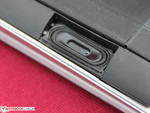
The small speakers are inside movable rubber buffers that allow the membrane to vibrate. The result is reasonable but cannot compete with high-quality multimedia notebooks. Especially not against notebooks with a subwoofer, there is basically no bass at all. The sound experience is very focused on medium tones; music enthusiasts can attach headphones or external speakers via the combined stereo jack.
Energy Management
Power Consumption
An energy consumption of 7 up to 12 Watts is a normal result for this notebook class. Compared to the U410 Touch (Ivy Bridge, 710M), the consumption has been reduced and the lowest consumption during idle was around 10 Watts. The consumption under load did not change, but this is a significant improvement if you consider the performance increase (710M -> GT 730M). 15-inch competitors with GT 740M/Radeon HD 8750M are similarly frugal: 6-10 Watts for the Aspire E1 572G and VivoBook S551LB (lowest brightness setting!).
| Off / Standby | |
| Idle | |
| Load |
|
Key:
min: | |
Battery Runtime
Battery runtimes are a strong suit of the U430 Touch; the 14-inch notebook manages almost 12 hours during idle. However, this is a very unrealistic scenario (minimum brightness, energy saving profile). Our WLAN test is more realistic with a luminance of 150 cd/m² (center) while webpages are refreshed via script. The battery lasts 5:29 hours, the competitors cannot keep up with that: Aspire E1 572G (4:26 h, 37 Wh) and VivoBook S551LB (4:51 h, 50 Wh). Our review unit does benefit from a slightly larger battery with 52 Wh. The predecessor U410 Touch only lasted 3:48 hours in the same scenario (probably lower capacity).
Verdict
Lenovo improved the IdeaPad U410 Touch and the U430 Touch has many positive aspects and only a few drawbacks. Especially gamers can benefit from the performance increase of the Haswell processor and the GT 730M graphics. The cooling solution is sufficient and enables the maximum Turbo clocks, which is very uncommon for thin ultrabooks. The chassis is even more stable and leaves a higher-quality impression compared to the predecessor U410. The input devices are convenient for frequent writers and the battery runtimes have been significantly improved (5:29 hours).
One interesting aspect is certainly the display with its 1600x900 pixels. However, the TN panel has problems with the viewing angle stability, a visible blue cast (pre-calibration) and the low luminance. The glossy touch panel comes with many restrictions for outdoor use.
One alternative is the less expensive Acer Aspire E1-572G (AMD Radeon HD 8750M, 600 Euros, ~$790) if you are willing to trade case quality for gaming performance. Asus’ VivoBook S551LB gets interesting if you want a high-quality aluminum case in combination with sufficient performance for gaming. However, neither of the two notebooks can compete with the stability or the HD+ resolution of the U430 Touch. The Asus Zenbook UX32VD starts at 800 Euros (~$1054, without Full HD, only GT 620M and Ivy Bridge); it is an alternative if you are looking for a very thin but sturdy aluminum chassis.




